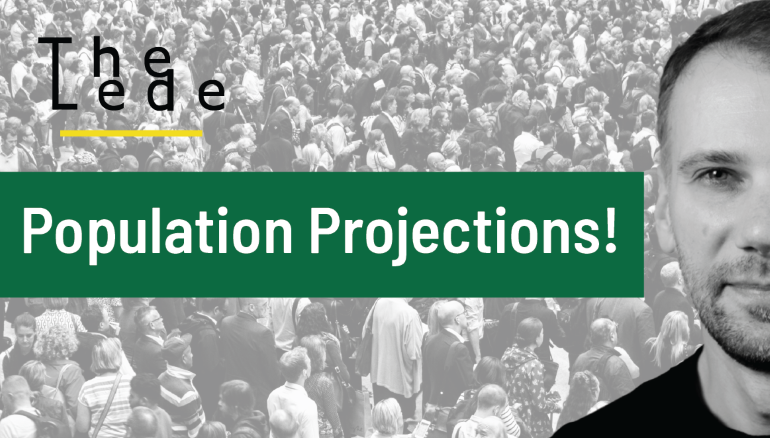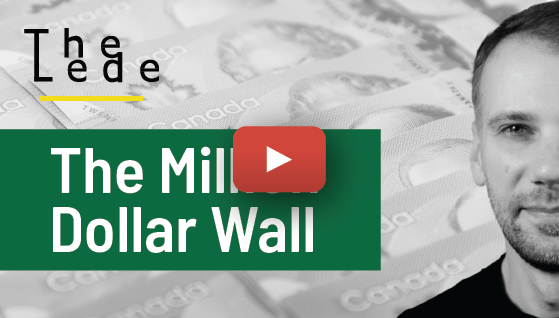The Lede blog: StatsCan population growth projections

Statistics Canada recently released their latest population projections for all Canadian provinces which include ten growth scenarios for each province. The scenarios range from low growth to high growth and include “fast-aging” and “slow-aging” scenarios, which help show how the aging of Canada’s population might shift the dynamics of growth.
Of the various sources for population forecasts that exist in Canada, Statistics Canada’s are among the most technically complex and robust available, so they’re always worth examining to get a sense of what future population growth might look like.
A glimpse of our future
Getting right into it, here’s a plot of what the various projection scenarios look like for British Columbia:

What’s interesting about this chart is that there are no scenarios for which Statistics Canada forecasts BC’s population to decline over the next 20+ years – it mostly just comes down to how fast or slow this province will grow and how young/old our population will skew.
In and of itself, this might not be wildly fascinating information to folks who aren’t statisticians, demographers, or economists. But when we consider the implications of these growth scenarios for the future of our local housing market, this story starts to get a little bit more interesting, especially when we fold in information about the components of population growth.
How we grow
What are the components of population growth? Simply put, they are the forces (domestic and from abroad) which underpin how our population grows.
When most people hear the term “population growth”, it typically conjures up the idea of families having children at rates that cause the population to increase as a whole. Historically, this was how a lot of populations across the world grew for centuries.
But in the last 100 years or so, with the advent of cheaper air transportation and the increasingly globalized nature of human society, the factors driving population growth in a lot of the world’s regions have changed – particularly in developed economies like Canada.
As a result, analyzing the components of population growth has since become a more important factor in understanding how population growth actually occurs.
Shifting shares
While it used to be that a lot of population growth was driven by domestic factors, immigration and interprovincial migration have become the dominant drivers of growth in places like BC, and by extension, its major regions like Metro Vancouver.
Among the myriad complex reasons for this trend, at least part of the explanation is that in Canada (as well as in BC) women are not having nearly as many children as they used to for a variety of complex social and economic reasons (e.g., higher labour force participation rates, changing social norms relating to having children, etc.).
The plot below illustrates the significance of the situation by tracking the Total Fertility Rate per Female (TFR) in Canada versus that of BC over the past thirty years.

We don’t make ‘em like we used to
At a TFR of 2.1, the population is technically considered to be replacing itself.
The full reasons for this are complex and beyond the scope of this short analytical note. But, crudely speaking, it (historically) required a pair of humans of opposite-sex to produce one child, and because male children have historically tended to slightly outnumber females, the math works out such that 2.1 children per woman is the magic number required to replace that generation of the population.
At a TFR below 2.1, the population is technically not growing on its own, and absent any other sources of population growth (i.e., migration), the population would be shrinking over time.
As shown in the previous plot, the figures for Canada and BC have been below 2.1 for over 30 years, meaning that Canada and BC have not historically been producing enough children to replace each successive generation of their population.
As a result, population dynamics in BC are such that in the not-too-distant future, BC would actually be shrinking without in-migration to the province.
How do we know this?
Au naturel

A strangely morbid concept, the “Natural Increase” is a commonly used metric to understand how a population is growing “under its own steam” (i.e., only accounting for births and deaths originating in the geography of interest).
In simple math, it’s defined as the number of births in the in some geography of interest (i.e., the province), minus the number of deaths, measured over some period (usually annual figures).
For people who like math and formulas, here it is, in its simplistic glory:
What’s interesting about the previous plot is that only two of the population projection scenarios suggest that BC’s population might continue growing, albeit modestly, through domestically driven growth (i.e., growth originating from within BC’s borders).
This only happens in the “slow-aging” and “high-growth” scenarios, both of which represent extreme opposite ends of the population projection scenario-spectrum – it’s likely that the path the future will take will settle somewhere toward the mid-range of the projections – something more like the mid-range population projections (M-series), specifically the M3 and M4 scenarios.
Under the any of the M-series projections, we can see that the natural increase in BC is not far away from becoming a negative number that becomes increasingly negative as time goes on (because of our large aging population).
What this means is that BC wouldn’t be growing in the future if it weren’t for two other key components of population growth, namely: interprovincial and international migration.
Making it all add it up
Putting all the pieces together, what this information tells us is that the population of people who are moving to our local market area will increasingly be coming from outside of BC’s borders – whether that be from international or interprovincial sources. And we also know that absent these forces, the population in BC (and quite likely in Canada) would be trending towards decline in the not-too-distant future.
In addition, it’s also known from the data that the top three destinations for recent immigrants to Canada in 2021 were Toronto (29.5 per cent), Montréal (12.2 per cent) and Vancouver (11.7 per cent). So, absent some kind of natural or humanitarian disaster, what this all adds up to is a recipe for sustained demand pressure on the housing market not just in Vancouver, but in BC as well.
Not all solutions are good solutions
If you’re a policymaker concerned with housing affordability, these basic facts about how our population will likely continue growing are probably enough to keep you awake at night. It’s indeed an incredibly vexing challenge.
On the one hand, in-migration from international and interprovincial sources is needed to sustain population growth, as well as a healthy level of economic growth in BC.
On the other hand, this growth introduces a deep pool of demand for housing in this region which doesn’t sleep while policymakers scramble to figure out what to do about it. There is a constant drip-drip-drip of population coming into this region (almost) every day which continues to add pressure on an already-strained housing stock.
In this context, it’s easy to see why politicians of all stripes are increasingly focusing political platforms on their proposals of how to alleviate the pressure, and there’s no time to waste.
However, when sampling the smorgasbord of policy-options put forth by all levels of government in Canada with respect to solving the housing crisis, one is easily left wondering: will the combined total of all these measures be nearly enough?


